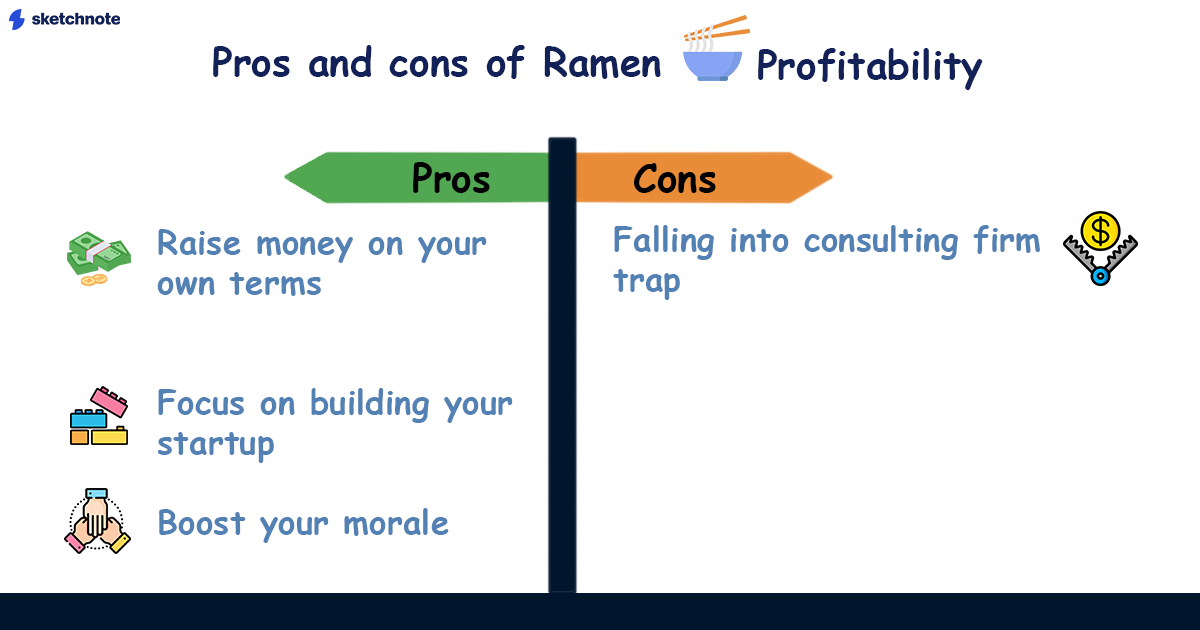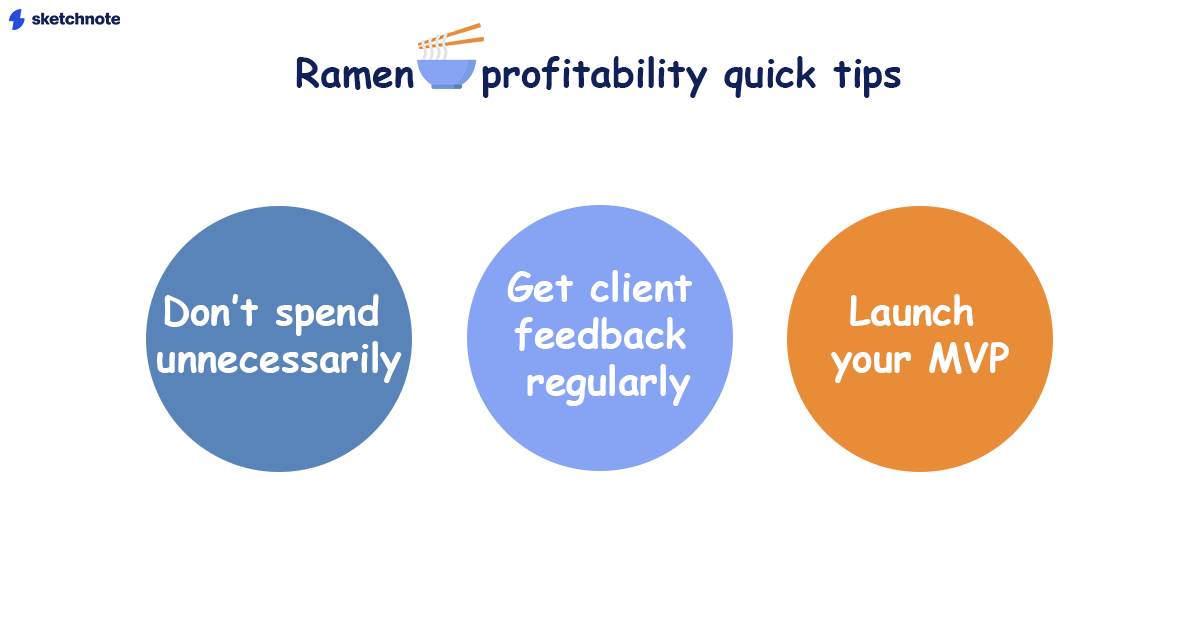Ramen Profitability is a term coined and popularized by the successful entrepreneur Paul Graham. It refers to the stage during which a startup makes “just enough to pay the founders’ living expenses,” or where they can afford to live off the cheapest food. In this case, ramen!
In theory, this situation may not sound like such a great one at first. Everyone wants their startups to be successful as quickly as possible, enough for them to make a good life out of it. However, the Ramen Profitability stage offers many benefits for startups, and can even become a decisive factor in achieving success for entrepreneurs.
What is Ramen Profitability?
Not many startups reach profitability in their time as a business. In fact, statistics show that only 40% of startups actually end up being profitable.
Graham explains that the traditional profitability concept does not have the same objective as Ramen Profitability. The conventional approach has the primary purpose of showcasing how viable a startup really is while achieving the most significant amount of earnings, which is also what startups have traditionally aimed for.
In contrast, the Ramen method intends to show the startup as an already established business, and not as a potential one.
This is because the moment you reach the Ramen stage, you can already pay the founders’ living expenses. Thus this makes it an already sustainable business.
Importance of Ramen Profitability for a startup
One of the main things Ramen profitability brings to a startup is time. When starting a business, time is extremely valuable. And this form of profitability buys you time to experiment with your product and business model, find more funding, and reach new milestones.
Reaching Ramen profitability is quite important for the general growth and productivity of the startup, since the founder can sustain themself. Now, they can actively focus on nourishing and growing the project, instead of putting the majority of their effort into finding more funding or raising money.
How to become Ramen Profitable
When uber-cautious VCs look for investment opportunities today, a huge criterion is to see if the business is already making any money or not. After all, growth-stage startups are traditionally less risky than early-stage ones.
Already generating money enough to not just pay employees but also the founders is a huge check mark. This is why one way toward Ramen Profitability is to already start charging users in your early stages. Simply because your product is in beta, doesn't mean your business model too needs to be in beta.

What are the benefits?
The potential positive outcomes that come from reaching Ramen profitability are many. For example:
It's leverage with investors
Let’s be clear, this doesn’t mean you're always going to be "bootstrapping" or that funding is not relevant for you and your startup anymore. It just means it’s not urgent, currently.
Thanks to your project covering your living expenses, the urgency to raise money disappears and becomes just a need for progress. You can still do it, and it will definitely be helpful. However, if you don’t, you’ll still be able to maintain what you have.
This lack of desperation for funding also gives you a better stand on future negotiations you hold with potential investors. You can easily avoid being taken “advantage” of to get a better deal. The thing about VC money is that the less you need it, the more it wants to be invested.
Not having such a strict dependence on your investors leads us to the next point.
Focus on what really matters
When a startup reaches a state where raising more money is not a necessity, founders can choose to focus on what really matters to them: The growth and accomplishment of their idea.
Once founders realize they can pump in all their time and effort into building their business instead of preparing for fundraise, productivity automatically goes up. The startup's development greatly benefits from the founders being able to concentrate on growth and growth alone.
Improve confidence and morale
Creating a startup and working on making it succeed is always difficult. And dealing with the constant ups and downs of this journey can have a real effect on the morale of everyone involved in this entrepreneurship. Once your project reaches Ramen Profitability, a big part of that weight is lifted for two main reasons.
First, the startup provides you with enough profits to guarantee your survival. You won't go hungry, that's for sure. The second is truly realizing what that means. Which is, that at this point, your business it’s more likely to succeed than fail!
What are the downsides?
Graham has also warned that not everything Ramen Profitability brings along is all good. This stage can also carry some side effects that—without the right mindset or conviction of what you want to achieve—can be the greatest downfall for a startup project. Graham observed that the main danger with this approach was that it could turn the startup into a consulting firm.
He explained that a startup has to be a project that offers something that people buy and use. However, Ramen Profitability can bring this sense of comfort to entrepreneurs, which can make them stagnate. If they lack the motivation to push further to the next stage, many founders might just stop where they are and turn into a consulting firm, instead of trying to create a product.
One may then tell themselves that they are Ramen Profitable as a startup, when in fact they aren't a startup at all. Startups have much potential for scalability while consulting does not. Losing track here is very easy.
Many entrepreneurs face the dilemma of whether or not to slowly shift to consulting and living a comfortable life. This could signal the end of struggling and pushing forward to grow your startup. However, this could mean it will cease to exist after this point.
While it's ok to do some consulting work as a side hustle at first, that can't be your goal. Your goal has to remain fixed on growing your startup. Ramen Profitability is just the route you take to that destination.

Tips to become Ramen Profitable
Becoming Ramen Profitable may sound like a very conceptual thing. But it really isn't that hard. One way that we mentioned right, in the beginning, is to start making money from the very beginning. Remember, even ramen costs money! Here are some more tips that can help you get started on the path toward Ramen Profitability:
Avoid expending unnecessary money
In this day and age, it's almost criminal to not leverage technology to achieve things without investing a significant amount of money in them.
Productivity tools, automation, new software for anything you could imagine, or freelancers are just one click away. There are many such solutions that you could use to help reduce the costs of running a company.
Get real feedback from your clients
Find a way to receive and organize all feedback you receive from your customers.
The more you listen to their needs and what they like and dislike about the product or service you are offering, the closer you’ll be to creating the perfect and most profitable version of your idea.
Launch an MVP
Launching an MVP (Minimal Viable Product) will help you with the two previously mentioned tips.
An MVP is a basic version of the prospected product or service created without much investment. It’s launched in the market to monitor how it performs and is regularly adapted and refined based on the feedback received from the customer base.
With this tactic, you can get very valuable feedback from your clients at a low cost, and even be able to get profits from it!
In the end, remember that when you hit Ramen Profitability, you've found someone that wants to pay you for what you're making. Your product idea works and all you need now is to have the discipline to take your startup to the next level. Ramen Profitability is an interesting stage in the journey, but stagnating here can be a death warrant for your startup. Think of it as time on the clock to make it to your next round of funding, on your terms and you'll avoid being complacent. Good luck!



